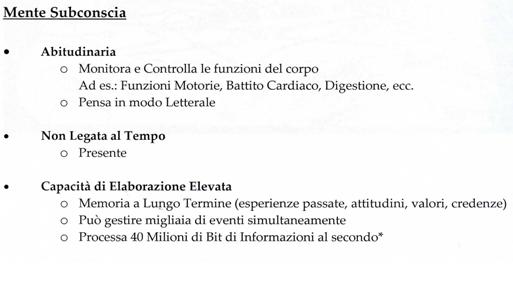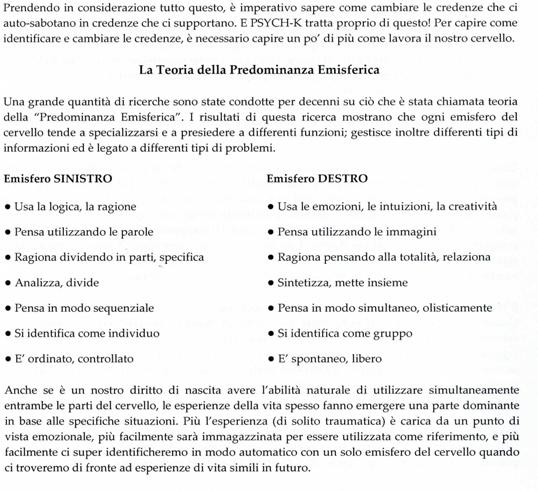Titolo: PSYCH-K® – Italiano
Autore: Piero Maina
Conteggio parole: 2049
Ho conosciuto PSYCH-K® dopo aver letto il libro del Dr. Bruce Lipton: “La Biologia delle Credenze”, che è diventato un best seller e il relativo dvd: ” La mente è più forte dei geni. Bruce Lipton è stato il primo scienziato che ha dimostrato in laboratorio come le influenze esterne/credenze, abbiano un ruolo maggiore del DNA nello sviluppo e nella vita delle cellule arrivando addirittura a modificarle. Avendo visto le potenzialità della mente inconscia e il sabotaggio che ne deriva dalle credenze limitanti, dal principio di scarsità e separazione che spesso governa i nostri pensieri quotidiani, ho voluto conoscere più da vicino il metodo PSYCH-K®. Ho frequentato il corso base di PSYCH-K® nel 2009 e ho avuto come istruttore Duccio Locati che oltre ad essere istruttore internazionale certifcato di PSYCH-K® è un affermato osteopata e tutte le informazioni sul suo lavoro le potete trovare all’interno del suo sito qui. Sono quindi diventato “facilitatore” di PSYCH-K® , che vuol dire che sono in grado di utilizzare le tecniche di bilanciamento di PSYCH-K® sia per me stesso che per gli altri. Ho completato il percorso partecipando al corso avanzato di 4 giorni nel mese di Maggio 2012 e questo passaggio mi ha permesso di comprendere meglio il funzionamento del processo di bilanciamento, approfondendo nuove tecniche e metodiche per il cambiamento delle credenze limitanti che sono presenti nella nostra mente inconscia.
Lo scopo di PSYCH-K® è infatti quello di permettere alla nostra mente inconscia di liberarsi dalle credenze negative/limitanti e autosabotanti che sono alla base dei nostri insuccessi o per meglio dire, che sono le fondamenta dei nostri pensieri che creeranno a loro volta la nostra realtà. Ora, per chi crede che la nostra esistenza su questo pianeta sia governata da forze/cause esterne alla nostra volontà, bisognerà prima convincerlo del contrario. Per quelli che sono già coscienti che QUALUNQUE esperienza ci accada o meglio sembra accaderci è una conseguenza diretta dei nostri pensieri consci/inconsci, bisogna spiegare qual è il pezzo mancate del ragionamento. Se a livello conscio prenderò delle decisioni su quelle che vorrei fossero le mie esperienze di vita, vedrò molto probabilmente naufragare i miei progetti se non avrò altrettanto allineate le credenze a livello inconscio; il problema saranno i paradigmi, abitudini e credenze che governano e influenzano ogni attività e modi comportamentali nella vita di tutti i giorni.
Alla base di quanto detto, c’è la lotta impari fra mente conscia e mente inconscia :
Da quanto apprendiamo dalle due immagini qui sopra, scopriamo che il 95% delle azioni che compiamo quotidianamente è gestito dalla mente inconscia e quindi dalle abitudini e automatismi che risiedono là. Pertanto possiamo affermare che anche se consciamente pensiamo in una certa direzione per un certo periodo, il disco che in sottofondo “suonerà più forte” e in maniera continuativa sarà senz’altro quello della mente subconscia….una vera lotta impari vista anche la differenza in termini di capacità di elaborare le informazioni (40 Bit/sec contro 40 Mio Bit/sec). Queste conclusioni sono il frutto di esperienze passate, dell’educazione che abbiamo ricevuto in età pre-scolare e sono immagazzinate nella mente subconscia. Queste credenze subconscie, creano dei filtri attraverso i quali vediamo e affrontiamo le sfide della vita. Sono le basi per le nostre azioni o reazioni utili per affrontare ogni situazione nella nostra vita. L’abilità di agire in maniera efficace sia a livello personale che professionale, è profondamente influenzata da credenze del tipo “Sono competente”, “Sono forte”, “Sono sicuro”. Con credenze come queste possiamo intraprendere progetti importanti con sicurezza e rimanere focalizzati senza perdere il controllo della situazione. Se invece avremo credenze del tipo “Non credo di poter fare un buon lavoro”, “Non controllo l’andamento delle cose”, procederemo esitando, temendo di fare errori, di subire critiche e di sbagliare. Come disse una volta Henry Ford: ” Che tu creda di potere o non potere….hai comunque ragione!”
Il riscrivere le nostre credenze limitanti a livello subconscio è come riprogrammare un computer. Utilizzando le tecniche di PSYCH-K® come una specie di “tastiera mentale” che comunica con il cervello, potete incrementare la comunicazione incrociata tra i due emisferi cerebrali, raggiungendo uno stato di integrazione emisferica, ideale per il cambiamento delle credenze subconscie. In aggiunta, quando l’emisfero destro e sinistro sono in comunicazione e lavorano simultaneamente, le qualità e le caratteristiche di entrambi gli emisferi sono disponibili per massimizzare il vostro potenziale.
PSYCH-K® è una delle tante vie che ci vengono insegnate per riprogrammare la mente inconscia in maniera veloce, semplice, efficace e rispettosa al fine di essere noi i padroni della nostra esperienza di vita e non “vittime” come spesso siamo portati a credere in maniera errata.
Concludo riportando qui sotto le Domande/Risposte su PSYCH-K® prese dal sito di Duccio Locati.
A presto!
PSYCH-K® è una serie di principi e di processi progettati per cambiare le convinzioni a livello subconscio che limitano l’espressione del tuo pieno potenziale di creatura divina che sta vivendo una esperienza umana.
Rob Williams, ideatore di PSYCH-K
Il Segreto della Vita sono le CREDENZE. Piuttosto che i geni, sono le nostre credenze a controllare le nostre vite. PSYCH-K® è un set di tecniche semplici di auto-aiuto per cambiare le credenze e le percezioni che hanno un impatto sulla tua vita a livello cellulare.
Bruce Lipton, PhD
Cos’è PSYCH-K®?
PSYCH-K è un metodo semplice, immediato e estremamente rispettoso per l’individuo che permette di riscrivere il software della nostra mente e di cambiare la matrice della nostra vita.
Sviluppato a partire dal 1988, PSYCH-K include informazioni e processi che permettono di accelerare incredibilmente la propria crescita personale. Questa tecnica veramente unica è un insieme di diversi strumenti per il cambiamento personale, alcuni contemporanei, altri antichi. Come molte delle innovazioni più importanti ed efficaci nel mondo, PSYCH-K è nato grazie a “una serie di intuizioni” generate da anni di ricerca e da migliaia di sessioni individuali e di gruppo. PSYCH-K è quindi una tecnica estremamente sicura, non invasiva ed efficace per cambiare credenze e percezioni antiquate, radicate a livello della nostra mente subconscia.
La nostra realtà è formata dalle nostre “credenze”. Queste credenze, di solito a livello subconscio, sono il frutto di una programmazione che inizia dai primi anni della nostra vita, e influenzano in modo drammatico il nostro comportamento e il nostro modo di “percepire” la vita in tutti i suoi aspetti. Diversi studi nella branca delle neuroscienze indicano che quasi il 95% della nostra coscienza è gestita dal nostro subconscio che è il deposito per le nostre attitudini, i nostri valori e le nostre credenze. Tramite le nostre credenze creiamo quella che è la nostra percezione del mondo e di noi stessi, e tramite queste percezioni sviluppiamo i nostri comportamenti. Spesso il modo migliore per cambiare un comportamento (e spesso abbiamo il desiderio di cambiare i comportamenti che sabotano la nostra vita e gli obiettivi che vogliamo raggiungere) è cambiare le credenze a livello subconscio che lo supportano. PSYCH-K, basato su anni di ricerca riguardo alla differenziazione degli emisferi cerebrali, conosciuta anche come teoria della predominanza emisferica (Brain Dominance Theory), offre diversi metodi per identificare velocemente e trasformare le credenze che ci sabotano, in credenze che invece ci supportano in ogni area della nostra vita: affettiva, relazionale, economica, lavorativa, e quella legata alla salute.
PSYCH-K è quindi un processo che può liberare la nostra mente dalle limitazioni del passato in maniera veloce, efficace e facile.
PSYCH-K® è un “sistema di controllo mentale?”
Quando si parla di subconscio uno dei timori primari è “stai tentando di controllare la mia mente senza il mio permesso?”.
Domanda lecita dato che ormai ognuno di noi è costantemente controllato quasi in ogni ambito della propria vita (ma qui apriremmo un discorso infinito). PSYCH-K dà gli strumenti e la conoscenza per permettere alle persone di controllare la propria mente e quindi di non essere vulnerabile ai desideri e alle volontà di altre persone, quando non corrispondenti ai nostri. Quindi alla domanda “PSYCH-K è un sistema di controllo mentale?” la risposta più corretta sarà: “Si, in un certo qual modo, PERCHÉ DA A TE IL CONTROLLO SULLA TUA MENTE”.
Cos’è il Test Muscolare e come funziona?
Il Test Muscolare è stato sviluppato 40 anni fa da Geroge Goodheart, D.C. (l’ideatore della Kinesiologia Applicata) negli Stati Uniti. In PSYCH-K, il test muscolare è utilizzato come mezzo per comunicare facilmente e direttamente con il nostro subconscio.
La mente subconscia controlla il Sistema Nervoso Autonomo ed è responsabile per il controllo nelle nostre funzioni fisiche e neurologiche autonome. Ad esempio, il nostro corpo si muove perché il nostro subconscio dirige una complessa rete di segnali elettrici che vanno al muscolo appropriato nel momento appropriato per portare a termine una azione che può essere quella di prendere un oggetto. La forza del segnale elettrico, determinerà la forza della risposta nel muscolo in questione; ma l’intensità del segnale elettrico è strettamente legata a quali pensieri ha la nostra mente in quel momento. Quando la mente sta mantenendo un pensiero “stressante”, si crea un conflitto elettrico che ridurrà la forza del segnale al muscolo, con una diminuzione di forza di quest’ultimo. La stessa cosa succede quando una persona dice una frase con la quale il suo subconscio non è d’accordo, con, di conseguenza una diminuzione della forza dei muscoli di tutto il corpo. Di conseguenza, il test muscolare può essere usato per determinare quali pensieri inducono stress a livello fisico, come per trovare quali credenze sono o non sono supportate dalla nostra mente subconscia. È stato ed è tuttora utilizzato in altri ambiti per testare l’efficacia di vitamine e minerali, disequilibri a livello dei meridiani energetici, stress organici, intolleranze alimentari, allergie, ecc… È importante specificare quindi che PSYCH-K e il Test Muscolare non sono sinonimi. PSYCH-K usa il test muscolare per comunicare con la mente Superconscia e subconscia. PSYCH-K è un insieme specifico di tecniche che ci permettono di cambiare le nostre credenze, che includono il test muscolare come mezzo per comunicare con il nostro subconscio e con il nostro Superconscio. Ma ricordatevi, il nostro subconscio non è un Profeta Infallibile! State attenti a fare domande sul futuro “Devo fare…?”. Come per ogni altra cosa si può incorrere nel rischio di abusare del test muscolare. Alcuni lo usano come la più importante “sorgente di Verità”, in alternativa al discernimento della mente conscia. Il nostro subconscio rappresenta la nostra realtà, non la Verità Suprema.
Come, delle credenze e degli atteggiamenti che ho da anni possono cambiare in pochi minuti con PSYCH-K®?
Molti pensano che credenze e atteggiamenti negativi siano come degli omini nelle proprie teste che tentano in tutti i modi di rendere la loro vita miserabile.
Come analogia potremmo prendere dei documenti di Word (quello di Bill Gates) immagazzinati nel computer come “micro documenti”. Sia il software del computer che le credenze immagazzinate nella memoria di una persona sono schemi di energia mantenuti in un campo elettromagnetico. Quando il campo è disturbato, questi schemi energetici cambiano. Uno schema energetico mantenuto nel computer per 30 anni, può essere modificato o cancellato con la stessa velocità di un altro che è nel computer da soli 30 minuti! E così è esattamente anche per la nostra mente. La chiave di tutto sta nel come cambiare lo schema, non da quanto tempo lo schema è presente.
Quanto spesso devo rinforzare un bilanciamento?
Questa domanda è legata alla credenza che non si possa realmente cambiare un vecchio atteggiamento o una vecchia credenza, e che quando meno te lo aspetti, tutti i tuoi vecchi schemi saltino fuori per toglierti ogni difesa e sabotare la tua felicità.
Occasionalmente un bilanciamento può richiedere alcune attività di supporto per accelerare il processo di integrazione della nuova credenza, ma è molto raro che una persona necessiti di fare esattamente lo stesso bilanciamento, per lo stesso obiettivo, due volte (personalmente non mi è mai capitato).
Devo ricordare le passate esperienze dolorose per risolverle?
Molte forme di psicoterapia assumono che l’entrare in diretto contatto con determinate emozioni o ricordi sia un pre-requisito necessario per ottenere cambiamenti significativi.
Per PSYCH-K non è necessariamente così. Nella nostra esperienza abbiamo visto che quando il subconscio ha bisogno di accedere ad un ricordo o ad una emozione passata per cambiare una credenza, lo farà, ma quando non è necessario non creerà nessuna catarsi emozionale giusto per accontentare le aspettative del paziente, del terapista o dell’istruttore. Ogni persona è differente e le soluzioni dei problemi sono diverse da persona a persona. Quindi, l’atteggiamento migliore è quello di non avere aspettative sullo svolgimento del bilanciamento ma rimanere curiosi circa quello che può succedere e rispettare la persona qualunque sia la sua modalità.
© Copyright Piero Maina – All Rights Reserved










